This was published 7 months ago
From truck-stop tyke to international cake queen: The rise of Nadine Ingram
Her cakes are adored by everyone from Nigella Lawson and CWA blue-ribbon holders to teenage influencers – but for Flour and Stone’s Nadine Ingram, that taste of success didn’t happen overnight.
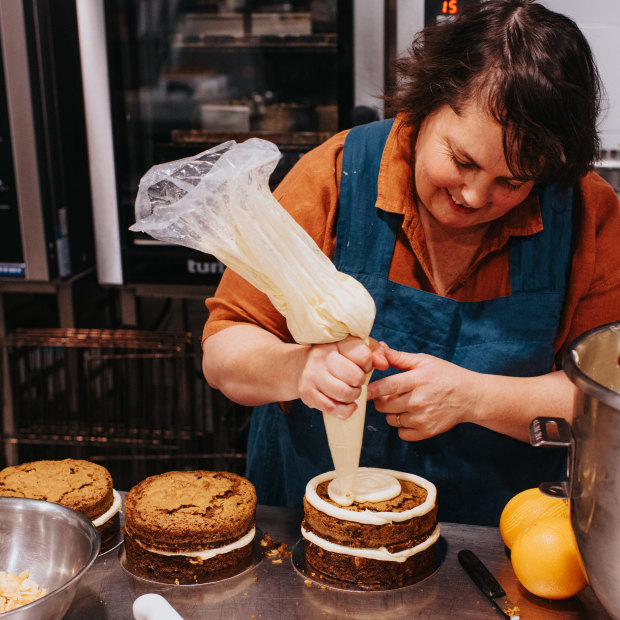
Nadine Ingram prepares carrot cakes with honey cream cheese icing. “I am extremely resilient and persevering,” she says of building Flour and Stone. “… But oh, it was a flogging at the start.”Credit: James Brickwood
When our daughter was a non-sleeping newborn, we used to make a pilgrimage each morning just before dawn. She was born in midwinter, so it was still dark as we left the house, but after a few minutes of walking, a yellow glow would appear: the light from the bakery at the top of the hill. Looking back, I still remember the way that glow, each day, would pierce my fog of sleep-deprived despair. It was the light of sanity and life and comfort after the endless dark of the night before. It was the light of human kindness and returning hope. It was the light of croissants.
Because of this, I suspect I’m slightly susceptible to bakeries. I have a tendency to ascribe magical and, frankly, unrealistic properties to them. Even so, there’s something pretty terrific about Flour and Stone at five in the morning. It has the requisite golden gleam, like a lantern in a forest, a beacon on a storm-tossed sea … you get the idea. Amid the tall, dark buildings of Sydney’s Woolloomooloo, it looks small and warm and comforting.
Inside, the thing that hits you is the smell. Smell is the wrong word. Fragrance? Aroma? Elixir? It’s viscous enough to be liquid, as if the air is undergoing a state-change, from gas to some concoction of treacle, vanilla and browned butter so rich you need to swallow in order to breathe. Imagine plunging your whole face up to your ears into your favourite cake while it’s still warm from the oven. That’s what it smells like.
The Flour and Stone shop frontages – there are two, the Pantry and the Annex, 20 metres apart – both have kitchens attached. Neither has windows, and despite their industrial ovens and stainless steel benches, they feel like subterranean refuges: Mole’s home in Wind in the Willows, just down the road from Bilbo’s Bag End. This morning, the Annex is bursting with various forms of freshly cooked, un-iced cakes. They’re sitting in rows on benches, layered in tiers on trolleys, rising with the light behind them in ovens. All of them are brown – not dull brown, but shades of shiny conker brown, glossy as a pony’s flank. Around them are piles of silvery cake tins, trays of golden butter and great bowls of creamy uncooked cake mix.
![Behind the scenes at Flour and Stone. “I didn’t enjoy [owning it] for the longest time,” Ingram says. “Because I was really trying to drive the business to be successful … Then your heart becomes engaged.”](https://static.ffx.io/images/$zoom_0.102%2C$multiply_1.545%2C$ratio_0.666667%2C$width_378%2C$x_10%2C$y_0/t_crop_custom/q_86%2Cf_auto/8ad30168da43cd1c5499509133230fdfec258045)
Behind the scenes at Flour and Stone. “I didn’t enjoy [owning it] for the longest time,” Ingram says. “Because I was really trying to drive the business to be successful … Then your heart becomes engaged.”Credit: James Brickwood
Several figures in black are moving around the kitchen, and in the midst of them is a small woman in brown – brown linen smock, brown knitted elf beanie – wielding a large serrated knife. This is Nadine Ingram, founder of Flour and Stone, illustrious mythmaker of cakes (or maker of myth-cakes, or both), and lifelong dreamer of the baking dream.
Nadine Ingram is an intensely romantic person. This romance finds its most famous expression in her cakes, so it’s not surprising that her long-awaited, luxuriously produced new baking book conjures wolves and goddesses and fables from the sea. “My cake for the siren Parthenope has a wreath of sour cherries for immortality,” she writes in Love Crumbs, published next month. “She can still be seen running along the sand and watching over Naples from the stars.”
For a Flour and Stone novice, it’s easy to be suspicious of such flights of food-related fancy. How much mythology can you really cram into a cake, after all –even a sour-cherry, Valrhona Manjuri chocolate cake? A fair bit, as it turns out. Ingram’s cakes are ridiculous: the sorts of creations a wild-eyed, Michelin-trained sorceress trapped in a gothic fairytale might make. The display counters of Flour and Stone are loaded with wrinkled, raspberry-studded chocolate and buttermilk cakes, pressed up against shaggy, panna cotta-soaked lamingtons, crowded next to bobbly walnutted carrot cakes, jostling in among drifts of creamy lemon meringue. Every single thing looks like something a cloaked figure on a blasted heath at midnight might offer you in exchange for your immortal soul – which could explain the fact that most of the people standing at the counter look like spirits in torment, agonised by the necessity of choosing between the prim, gingham-aproned perfection of the lemon drizzle cake, and the blowsy come-hither sinfulness of the pear tatin. (They resolve this agony, almost inevitably, by ordering both.)
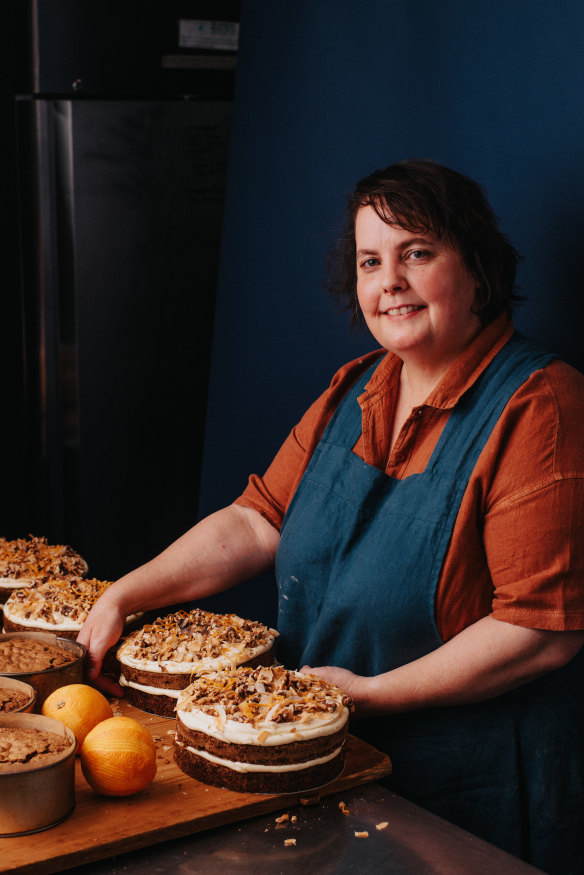
“It’s felt like cutting off my arm,” Ingram says of trying to spend more time out of the kitchen.Credit: James Brickwood
The fame of Flour and Stone is based on this romance: on the idea that, as Ingram writes, “the intentions of the baker become infused into the cake … through all the mixing and folding, our emotions … find their way into the crumbs.” These days, Flour and Stone is synonymous among foodies everywhere for a certain kind of generous, home-made deliciousness. A Nadine Ingram cake is recognisable in a line-up of patisserie produce precisely because it doesn’t look like it was produced by a pâtissière: the meringue is too extravagant, the chocolate shavings too luxuriant, the sponge too pillowy and wonky and buttery. Professional chefs buy each other Flour and Stone cakes; so do midlife CWA blue-ribbon winners; so do 18-year-olds with 18-inch waists. So do international celebrities: Nigella Lawson rhapsodises frequently about Ingram’s “exquisite” baking. “I love absolutely everything @nadineingram does,” she posted last year.
‘Nadine is still the first one to be scrubbing the back dock or washing the dishes.’
Ingram’s longest-serving employee, Samantha Denmark
In person, the creator of all this sweet-treat transcendence could be a character from her own fairytale: flyaway hair, unlined skin, apple cheeks. But Nadine Ingram, 51, comes from coal-mining country near Newcastle in NSW, where fairies are thin on the ground (though it might be good gnome territory), and her first seven years were spent living at a truck stop halfway between Putty and Singleton owned by her maternal grandparents. Her parents worked the petrol bowsers, she explains, “and on my birth certificate, it actually has ‘pump attendant’ for Mum and Dad’s professions.” She laughs. “I mean, what would people imagine that even was? Some aerobics exercise, maybe?”
Ingram’s own vocation has led her far from these origins – though she has a kind of pragmatism and lack of pretension that feels more gnome than fairy, and perhaps it’s the combination that has made her successful. For day after day, year after year, she’s been willing to do the back-breaking work of building effervescent edible dreams: meditating on the magic of scones while hauling bags of flour out of the loading dock; channelling the goddess Athena while cleaning out the cold storage and scouring 20-litre jam pans. “She’s worked so hard,” says her longest-serving employee and friend Samantha Denmark, the illustrator whose beautiful botanical pictures feature in Love Crumbs, and who began icing gingerbread biscuits in Ingram’s first business, Cookie Couture, 16 years ago. “Nadine is still the first one to be scrubbing the back dock or washing the dishes.”
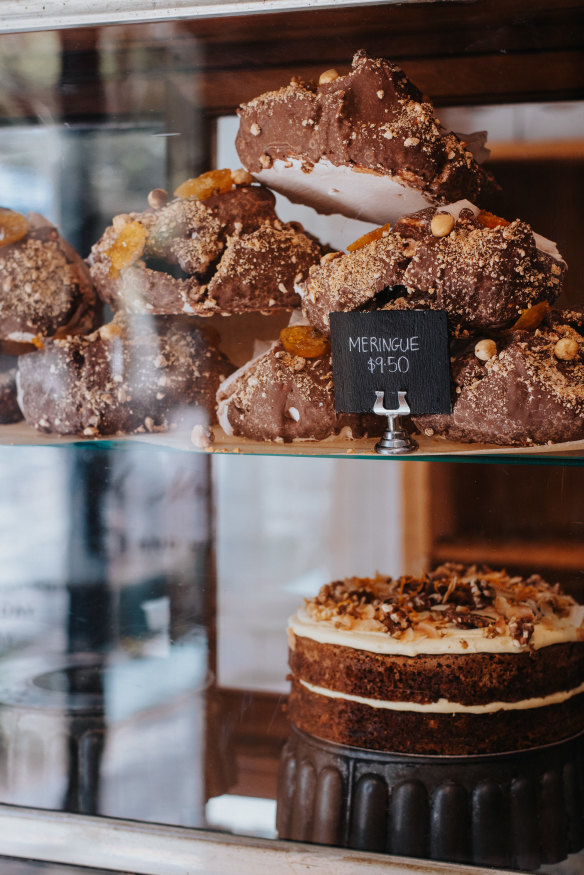
Flour and Stone’s extravagant meringues and carrot cake.Credit: James Brickwood
But now, things are changing. For the past few years, Nadine Ingram has been trying to move herself off her own roster and out of her own kitchen. It has felt necessary, she says, but it has not felt easy. “Basically, it’s been like cutting off my arm.”
Since Flour and Stone made her famous, Nadine Ingram has done lots of podcasts and TED Talks and cooking classes. My favourite video is one in which she demonstrates the cooking of three cakes in just over an hour, encouraged by her friend and publisher, Julie Gibbs. In this video, you can see Ingram working hard to get everything done; there’s a lot of “here’s one I baked earlier” substitutions of sponge and pastry cream and compote. But there are some things she clearly can’t skim over, whatever the time pressures. She spends several minutes, for instance, explaining in detail how to combine butter, sugar and eggs: how the butter and eggs must be truly room-temperature to prevent curdling (“which would make a heavy cake,” interjects Gibbs in tones of doom. “Yes, yes it will!” says Ingram).
As she ices lemon drizzle cakes in the Annex kitchen at 5.30am, you can see this perfectionism in action. Ingram stands square to the bench, shoulders back. She taps each cake out of its tin, flips it onto a cake board, wipes the bench for crumbs. She slices away the uneven top surface, feeling the level with the flat of her left hand. She lifts off the waste crumb with the knife, flips the cake onto a second board, brushes it off, and sets it down with its bottom side up. Then she pours a thick blob of drizzle icing, loosened with lemon juice, onto the cake’s centre, massaging it towards the edges with a spoon she keeps specifically for this purpose because it has “the right angle and weight in the hand”. Gently, the icing slides over the edges and down the sides of the cake in delicate tears.
I know from bitter experience how hard it is to achieve these tears, instead of (my signature look) heavy globs that smother your cake and puddle on the plate beneath. But Ingram does it swiftly, almost unconsciously, with a kind of easy mastery. The whole process takes about three minutes.
This kind of technique, of course, is the result of her training, and more than three decades on the job. She comes from a world of classically trained chefs, working in Michelin-starred restaurants, in which perfectionism is often indistinguishable from fanaticism. Having done her apprenticeship in the Hunter Valley (at Kirkton Park under chef Susan Tulloch, the first female sous chef at London’s Savoy), she moved to England at 19, and worked for Michel Roux jnr at the two-Michelin-starred Le Gavroche. (It was later awarded three stars.) Her station was suitably Dickensian: down in the basement of the Georgian building, with pheasants hanging over the chopping block and chestnuts roasting in the winter dark.
‘My ego got away from me early on because of the models of the chefs (with whom I trained) … I thought yelling was how you got results. But I realised I was losing staff.’
Nadine Ingram
“On my very first day at Gavroche, they gave me this huge tub of onions to brunoise,” she recalls. (Brunoise is French for fine dice: a classic brunoise involves cubing vegetables into 1mm–3mm squares.) “My knife skills were so bad that my brunoise was a disaster, and at the end of the day they were just looking at it, and they were like, ‘Did you actually apply for a position in the pastry section?’ So I straightaway said, ‘Yes!’ Because they would have sacked me otherwise, and I was desperate not to go home. And so I became a pastry chef.”
She would be in England for six of the next 10 years, working at Le Caprice, The Ivy, and Lindsay House. It was a thrilling time, but also traumatic. Fresh from her modest rural background, she was suddenly encountering the full glamour of international haute cuisine. But just as she was falling in love with European culinary tradition (and falling in love, full stop: she knew she was destined to be with now-husband and fellow chef Jonathan Ingram after a single shared glance over a pan of artichokes), she was also discovering that this glamour had a dark side: a poisonous professional culture in which being belittled and abused was par for the course.
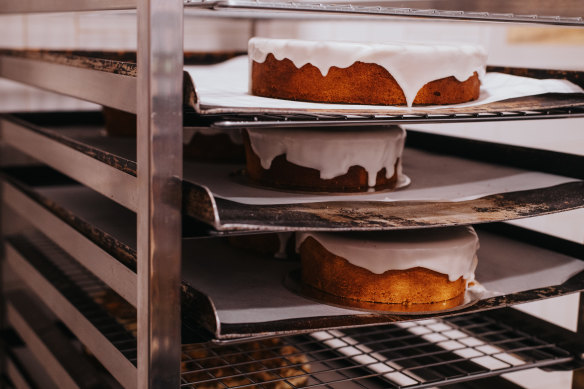
Flour and Stone’s lemon drizzle cake.Credit: James Brickwood
In old interviews with Ingram, that abuse looms large. “But actually, I’ve changed the way I look at those years now,” she explains after she’s finished the lemon drizzle cakes and we’re eating breakfast in the cafe, sharing a piece of leek and gruyère tart so delicious that every time I take a mouthful, I momentarily lose track of the conversation. “Part of the storyline of Flour and Stone – which I stopped talking about because I don’t feel like it’s me any more – is how my ego got away from me early on because of the models of the chefs that I worked with over those years. I thought yelling was how you got results. But some years ago, I realised I was losing staff because I was being a dick.” She takes a bite of tart. “It was terrible; I knew I had to do something.
“I think you can tell a story in various different ways,” she says after a moment. “And for a long time, I told the story of London being so hard, and how it impacted me. I often think about when I worked at Lindsay House in Soho. Richard [Corrigan, the head chef] was a tyrant.” She shakes her head. “But I loved that place. And I learnt from Richard how to only put on the plate something that belongs there – which helps me think about what I’m putting in a cake: does it really belong?
“And while I was reflecting on that, a friend said to me: ‘What is the purpose of this whole [Flour and Stone] thing? What do you love, what do you want to pass on?’ I’d thought the purpose was just executing my clever recipes, and showcasing all these things that I’d learned. I’d forgotten that there’s this whole community around me that I wanted to nurture and be part of. Not just the community out there –” she gestures out of the cafe window – “but in here as well.” She looks down at her plate. “I think I have a high level of self-awareness. And I could see what my attitude was doing to people around me. So I decided that building that community, and our connection with each other – that’s what I find really satisfying.”
One of Ingram’s enduring characteristics, says Sam Denmark, is that she’s always trying to improve: herself, her business, her life. “She always wants to do something new, something fresh. And she doesn’t let anything stand in her way. She just decides, ‘Well, I’m going to do this.’ And she does it.”
And so Ingram decided to become a better boss. She changed the way she interacted with staff – so much so that today, she does not criticise anyone in the kitchen, ever. Instead, she takes any issue to her managers, and lets them handle it. She also runs in-house projects like the bakery’s spring carnival, where staff are encouraged to bake their own recipes to sell in the cafe. This initiative, it must be said, while thrilling for young pastry chefs, drives Ingram’s husband Jonathan to something near despair.
The pair married in 1997 and Jonathan gave up his own career as head chef at the Verandah restaurant in Sydney to look after their daughters Poppy, now 22, and Ruby, 18, (after whom Flo(we)r and Stone is named) and become “the Swiss Army knife” of Flour and Stone. “He really is a saint,” says Ingram. “He supported me through Cookie Couture, which never made any money, then he turned round and supported me again with Flour and Stone.” Jonathan does the ordering for the bakery, and he explains that “Nadine never thinks about the price of anything. If one of her staff wants to use fennel pollen in their recipe, she’s like, ‘Go for it!’ Fennel pollen is $12.50 for three grams. If you sneeze, you lose it all.”

With husband and fellow chef, Jonathan, and daughters Poppy (centre) and Ruby.Credit: Courtesy of Nadine Ingram
In pursuit of greater kitchen harmony, Ingram has even made all her 30-odd staff sit the Myers Briggs personality test – the results of which are pinned up in the Annex – to help everyone understand each other. “Almost all of us are Feeling rather than Thinking,” she says. “And Introverted rather than Extroverted. Lots of introverts in pastry.”
All this has created a workplace that feels, to an outsider at least, like a genuinely warm, encouraging place to work. Or is that just all the glucose in the air? “Well, she can still be pretty blunt!” says Denmark. “She’s still a fiery person. She is passionate, and she does want things to be done a certain way. But I think she’s like, ‘Well, if an apprentice comes through our kitchen and leaves and they don’t know how to, like, line a tart properly, or make a sponge properly, then we haven’t done our job.’ ”
In her own psychometric testing, Ingram proved herself to be, surprise surprise, both Feeling and Introverted. This seems to fit her for a life in what she calls “the pastry dungeon” – but in fact, ever since she left Sydney’s MG Garage (where she worked for the late chef Jeremy Strode after she returned from England) and joined the newly opened Bourke Street Bakery in early 2004, she’s loved interacting with the pastry-buying populace.
“There’s a lady who comes in here, almost every morning, for toast and jam,” she says now, leaning forward over some kind of delicious, caramelised rhubarb draped over crunchy, flaky pastry that’s arrived at our table. “And Jackie [Bubalo, Flour and Stone’s equivalent of a maître d’: warm and eagle-eyed] noticed that she liked her toast cold: she had this system of leaning her toast on her fork so it wouldn’t go soggy on the plate. Jackie mentioned it to Jonathan, and Jonathan bought her a little toast rack.” Ingram sits back, delighted. “Except our thick sourdough didn’t fit in the little toast-rack slots, so he had to wrench it round, so it’s a little bit skew-whiff.”
The lady must have been thrilled, I say.
“Oh, she was beside herself. She’s so my kind of person: quiet, very self-contained: you can imagine her belonging to the CWA. We talk about jams and things. Oh, but then …” She puts one hand up in warning. “I made this crab-apple jelly, and I was so proud of it. But then the second batch was a disaster – and Jackie served it to her! And the next time I saw her, she just said to me: ‘I tasted your jelly. Shame it didn’t set.’ And the whole team was just like …” Ingram pulls a horrified, gritted-teeth emoji face “... ‘Nobody say
anything!’ ” She laughs. “But she brings me almond tree leaves so I can make almond leaf custard, peach leaves: gorgeous things.
“I didn’t enjoy [owning Flour and Stone] for the longest time,” she continues. “Because I was really trying to drive the business to be successful, so that I could say that I did something that worked. And then, eventually, all the other things came into it. Like, you realise that you’re responsible for people’s livelihoods who work for you. Or that the people who are coming here to buy your pastries are, you know, undergoing cancer treatment. It’s those things that put everything into perspective. And then your heart becomes engaged.”
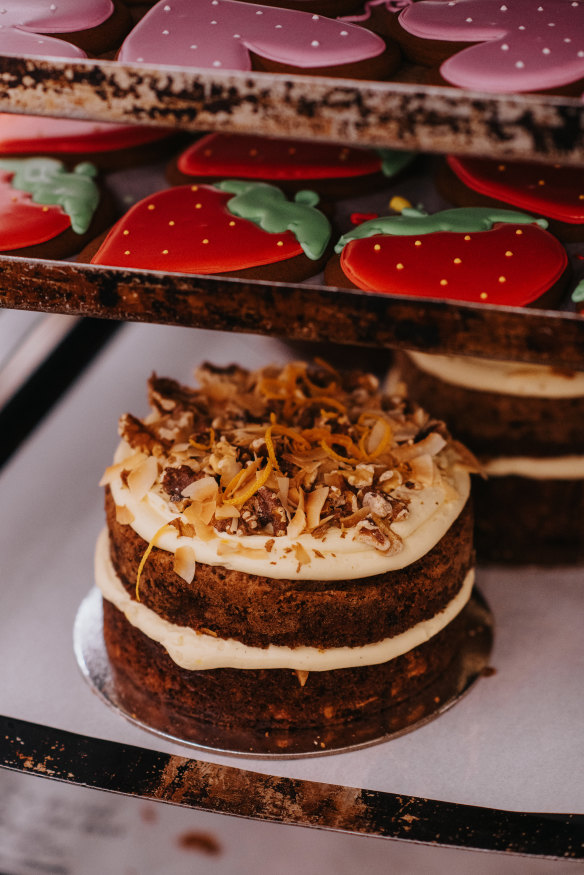
Ingram says her chef training years were hard, but taught her “to think about what I’m putting in a cake: does it really belong?”Credit: James Brickwood
Not everyone loves Nadine Ingram. Online, for instance, there’s a small but peeved community of people who have been unable to make some of her
recipes work. In particular, they have failed with the Lemon Dream cake, which featured in her first Flour and Stone cookbook, released in 2018.
“I’ve tried the Lemon Dream cake three times with it being a disaster,” wrote justtolurk12345 on the subreddit thread Ask Baking last year. “I want to love the book but it makes me feel so inadequate as a baker.”
“I spoke to a friend of mine who is a chef,” responded vw90, “and they told me that they don’t know a single person (including fellow chefs) who has been able to make the Lemon Dream.”
“I am very sorry to hear that,” says the publisher of both Ingram’s books, Julie Gibbs. The Lemon Dream is a complex cake, she admits – layers and meringue and sponge and lemon curd – but in a sense, this is the point.
“These cakes of Nadine’s are cakes that you bake with intention,” Gibbs goes on. “You bake them deliberately, you bake them with love, and you bake them with an outcome in mind, for someone that you really care about. These cakes are an expression of love.” And who said love was meant to be easy?
… Or mistake-free, if it comes to that. As it turns out, the Lemon Dream recipe in the original edition of the Flour and Stone book is hard to make because the recipe actually contains errors. The mistakes were corrected long ago on the bakery’s website and in subsequent editions of the book, and in fact, cookbook history is littered with similar stories – the infamous (and aptly named) Nemesis cake from The River Cafe Cookbook springs to mind – so Ingram is in good company. Nonetheless, you can’t help feeling a pang for all those hapless people, starting out with their dozen eggs and their half-kilos of sugar with such hope, only to be crushed by forces beyond their control.
“All you want is for your recipes to work,” says Ingram when I ask her about this episode. “So when they don’t, it’s awful. There was a problem with the sugar-to-egg ratios in the Lemon Dream; and also, my directions were bad. I think I try to write my recipes as if I’m holding the hand of the person making them – and I felt like I let go of their hand for a moment.”
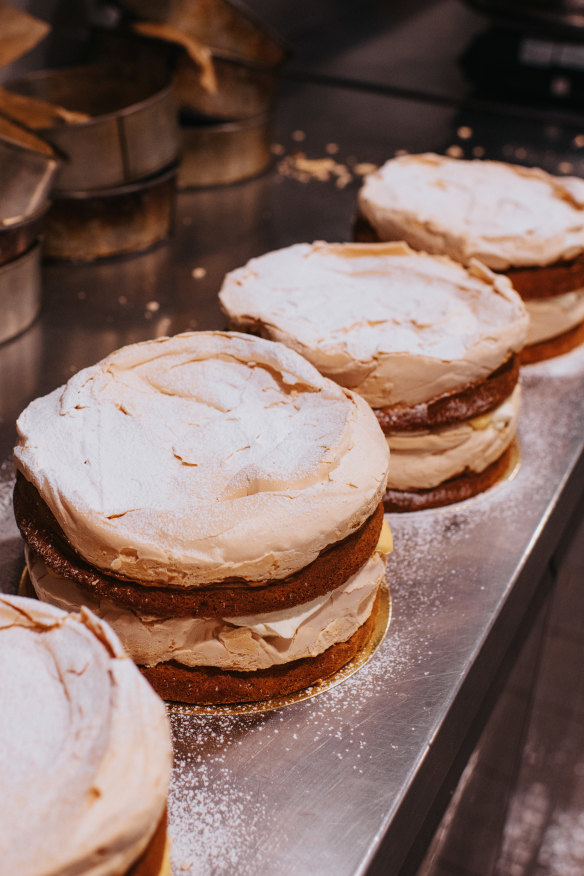
Flour and Stone’s Lemon Dream cake.Credit: James Brickwood
Ingram tests her recipes up to five times before publishing them – but given the wild variability of cooks, ingredients and especially ovens, there’s always the possibility of failure. That being said, Love Crumbs does not take a backwards step in terms of complexity. In fact, quite the reverse. Many, many of the recipes contain the phrase “the day before” – which means, effectively, “Strap in: this is a two-day project.” At least.
For Ingram’s fans, of course, this investment is part of the thrill of baking her cakes, and it’s certainly a necessary quality for their success. You don’t achieve a cake called Home (involving tomato, passionfruit, strawberry, sunflower seeds and pepper) by chucking a few things in a mixing bowl when you have a spare five minutes. “This book really shows that, along with being a baker, Nadine is an artist,” says Gibbs – and great art asks us to think more deeply, feel more strongly, and open ourselves to the challenge of making something edible from basil and white peach and ricotta and nettle.
It’s common – I’m a prime culprit – to associate baking with a lot of simplistically warm and fuzzy emotions. And it is a happy and reassuring and peaceful pastime. But it’s also exacting and precise and disciplined, and at times, intimidating. Nadine Ingram learnt this reality long before culinary school or the tribulations of London. She learnt it from her grandmother.
‘I am an intuitive baker. I tell when things are right by the way they look, or feel, or smell. My grandmother could tell her scones were ready by the smell.’
Nadine Ingram
Ruth Turnbull was not a warm and cuddly woman: there was no little Nadine pulling up a chair and plunging her hands into the pikelet mix. “She was a very stoic woman,” explains Ingram. “She did not waste time on the frivolity of teaching. The kitchen was always her domain, and she was very individual; she liked to do things just on her own.”
Nonetheless, Nadine ended up in the kitchen a lot. After her grandparents sold the truck stop, they bought a farm, and the Ingram children – Nadine has a younger brother – spent large portions of their childhood there. Let loose among the vegetable fields and orchards, Ingram began to build the foundations of her creative world. She also learnt to bake. “I’m not an outdoors person. My grandfather would be herding the cattle, and I would be trying to help, and he’d be like, ‘Nadine, you are hopeless. Go back inside.’ But inside, you couldn’t be seen to be doing nothing. You had to be useful. So I’d do craft, or bake.”
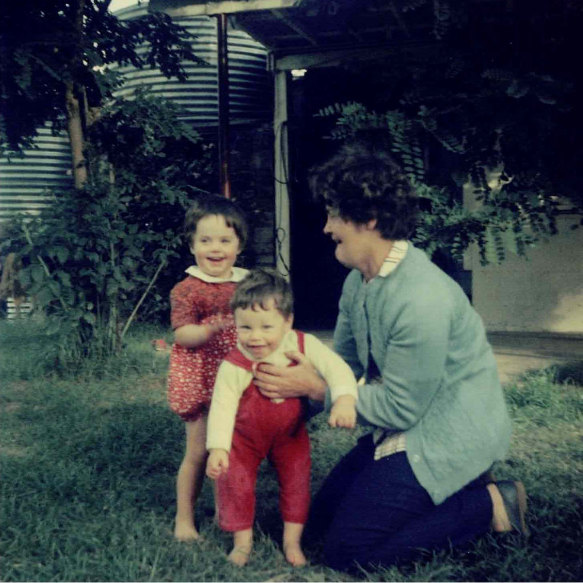
A young Ingram (left) with her brother and her grandmother, Ruth Turnbull, who taught her to bake “by osmosis”.Credit: Courtesy of Nadine Ingram
Ruth did not teach Nadine recipes or correct her technique. But she let Nadine observe, and try things herself. “I do think I learnt a lot from her by osmosis. I am an intuitive baker: I tell when things are right by the way they look, or feel, or smell. My grandmother could tell her scones were ready by the smell.”
Somehow, Ruth’s undemonstrative presence gave Ingram confidence, and she loved her wholeheartedly. It was Ruth she turned to, for instance, when she was opening Flour and Stone. “I wanted her handwriting for the store sign. So I asked her to write out ‘Flour and Stone’ for me. She thought it was a bit silly: ‘What’s this for?’ But she sat down. And she was so … you could see the concentration on her face. She did it a few different times – she really wanted it to be good.”
Flour and Stone – complete with its looping, cursive sign – opened its doors in November 2011. And for the next 18 months, it steadily lost money. “I remember our takings were $600 a week, and our wages were three times that,” says Ingram. “And that was just wages – I was way behind on super. It took years to get on top of it.”
Things changed in 2013, after Gourmet Traveller magazine published a six-page spread of Ingram’s recipes. Seven years later, firmly established as a petite pastry powerbroker both nationally and internationally, Flour and Stone opened the Annex extension. Days later, COVID lockdowns began, but the business sailed through the pandemic. “I am extremely resilient and persevering,” says Ingram matter-of-factly. “I think that’s key, beyond everything else, really. But oh, it was a flogging at the start. And even once it was working – for years and years, I just felt so responsible for everything. I remember a friend saying to me, ‘Do you know who Atlas is?’ And I said, ‘Yes.’ And he said, ‘You do not need to be Atlas!’ ”
The need to lighten the load, both physically and emotionally, was one of the main drivers for Ingram’s decision to get herself, physically, out of the kitchen. “I knew I couldn’t sustain it,” she says. “I’ve been doing it for 30 years: early mornings, long days, just hard physical work. As you get older, you realise it’s got to change. And I wanted it to. But I had this sense of, ‘If I’m not in the kitchen, how am I contributing?’ Seriously, I reckon for two years I was hung up about that.”
It was also a question of ego, she admits. “As you’re getting older, you realise that you’re not as fast as everyone else. Like the old-fashioned vanilla cake: I can’t bake it as well as what they bake it now. So I had to make peace with all that. Everyone was telling me it was OK – but you’ve got to find your own way to it. Nobody can tell you.”
Finding her own way involved exploring the same kinds of inspiration she uses in her cakes – nature, poetry, fables. And community. As Ingram puts it: “I like taking bits and pieces from all sorts of things.” So she took theories about midlife from Chip Conley, founder of the Modern Elder Academy, who believes in the upsides of life beyond 40. She took notions of human identity and happiness from Anglo-Irish poet David Whyte – attending a walking tour with him in Cumbria. She delved into ancient myths of gods. “I found this image of a kind of divine guru,” she recalls, “sitting cross-legged in the yogi position. And he just had the word ‘leader’ underneath him.” She leans back and takes a breath. “Sorry! I’m getting emotional. But I just thought, ‘That’s the place that I want to get to. To be able to sit there, just observing the things around me, and not feeling like I need to cut in.’ ”
She now works three days a week in the Flour and Stone kitchen, and one day in the office. “I can’t tell you how pleasant it is,” she says. The day away gives her time to explore new ideas, and new stories, and new dreams of cake – dreams she’s hoping might gather real-world momentum with the publication of Love Crumbs. “I’m hoping it gives me some pathways into some interesting collaborations.” She wants to do baking classes, and events with people she admires, and more community-building stuff, “though I don’t really know what that’ll look like, to be honest.”
These seem surprisingly modest goals, I say. “It’s true,” laughs Ingram. “But I’m really enjoying the way things are at the moment.” She has no desire for a franchise, or even one more store, or anything other than her modest, massive goal of changing the world, one cake at a time.
“I always remember Michael James [a baker and former colleague at Bourke Street Bakery] saying he would be happy with just one successful bakery,” she says, brushing the crumbs from our table into her hand. “And never a truer word was spoken. Honestly, I’m just happy with one successful bakery.”
To read more from Good Weekend magazine, visit our page at The Sydney Morning Herald, The Age and Brisbane Times.